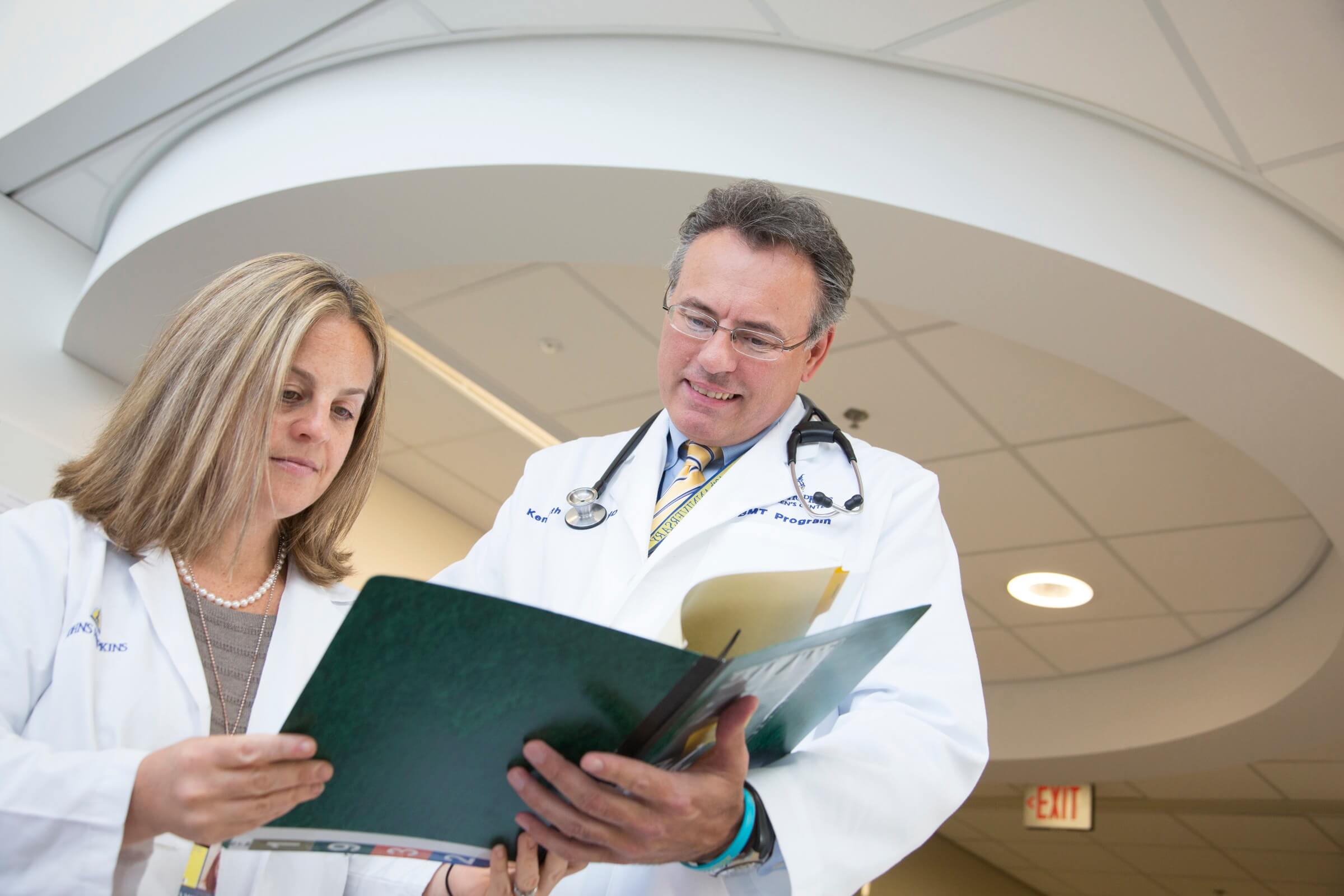Haploidentical Bone Marrow Transplant
 Drs. Heather Symons and Ken Cooke
Drs. Heather Symons and Ken CookeThe lack of adequate bone marrow donors to match the needs of patients was the inspiration for Johns Hopkins scientists who pioneered haploidentical bone marrow transplant (BMT). This breakthrough discovery makes bone marrow transplant possible for nearly every patient who needs the treatment.
In haploidentical BMT, parents, siblings, and potentially aunts and uncles, nieces and nephews, half-siblings, and grandparents can safely serve as donors. Our experts have performed more than 500 hapliodidentical transplants for adult and pediatric leukemia and lymphoma with safety and toxicity comparable to traditional transplants. This safety has made it possible for this type of BMT, available only at Johns Hopkins, to be used to treat many types of cancer and non-cancerous pediatric diseases:
- pediatric hematologic malignancies
- pediatric solid tumors, to induce a graft vs. tumor effect and reduce recurrence in high-risk cancers.
- sickle cell anemia
- immune diseases
- in conjunction with solid organ transplants to prevent organ rejection and eliminate the risks and costs associated with lifelong treatment with immunosuppressant drugs.
Half-Matched
Pediatric Oncologist Dr. Heather Symons explains her research involving childhood leukemia patients and bone marrow transplants, specifically half-matched or haploidentical transplantation.
Haploidentical Bone Marrow Transplant Clinical Trials
Pediatric bone marrow transplant expert Heather Symons is directing a clinical study of haploidentical bone marrow transplant for patients with refractory and/or relapsed high-risk leukemia and lymphomas. The study is available only at Johns Hopkins. Symon’s novel trial uses half-matched donors and, therefore, is an option for almost any patient where BMT is indicated. The safety and toxicity of haploidentical bone marrow transplants performed to date is comparable to matched transplants. As a result, the strategy is now being used in earlier treatment of pediatric leukemias and lymphomas, and has been expanded to include children with solid tumors, such as sarcoma and neuroblastoma to incite a graft versus tumor effect and prevent cancer recurrence.
Haploidentical BMT Clinical Trials:
A phase II trial of partially HLA-mismatched (HLA-haploidentical) bone marrow transplantation for high-risk solid tumors.
Purpose:
Allogeneic hematopoietic stem cell transplantation (HSCT) may be associated with a clinically significant "graft-versus-tumor" (GVT) effect, even against disease that is unresponsive to chemotherapy and radiation therapy. Graft-vs.-tumor (GVT) effects have been described after allogeneic HCT for neuroblastoma, Ewing sarcoma, osteosarcoma, rhabdomyosarcoma, melanoma and hepatoblastoma.Our goal is to maximize a T cell and NK cell mediated graft versus tumor effect in poor prognosis solid tumor patients using haploidentical donors, T cell replete bone marrow, and a unique post-transplant immunosuppression regimen containing post transplantation Cy and an mTOR inhibitor. This therapy will be widely applicable because almost all patients have a half-matched donor available (parent or sibling). We hope to demonstrate the safety and feasibility of this therapy in anticipation of combining this platform with additional post-transplantation therapy such as cryoablation, Donor Lymphocyte Infusion (DLI), stem cell directed therapy, immunologic checkpoint inhibitors, and/or metabolic inhibitors.
A Pediatric Blood and Marrow Transplant Consortium (PBMTC) multi-center Phase II Pilot Trial of Myeloablative Conditioning and Transplantation of Partially HLA-mismatched T cell replete Bone Marrow with post-transplantation cyclophosphamide for Pediatric Patients with Hematologic Malignancies
Purpose:
We propose a multi-institutional phase II study in children with high-risk leukemias in 1st CR, acute leukemias in 2nd CR, MDS, and JMML. The myeloablative conditioning regimen prescribed will be TBI-based for lymphoid leukemias and busulfan-based for myeloid leukemias, or for lymphoid leukemias in which a TBI-based regimen was used for the first transplant. Our goal is to establish an easily exportable, inexpensive platform for haplotransplantation that has a safety profile equivalent to matched related and unrelated BMTs. The primary objective will be to estimate the incidence of 6-month non-relapse mortality, hypothesizing that NRM is less than 18%.
Bone Marrow Transplantation and High Dose Post-Transplant Cyclophosphamide for Chimerism Induction and Renal Allograft Tolerance
Purpose:
Kidney transplantation is a good treatment for people with end-stage kidney disease. However, there is still much to learn about how to best care for the transplanted kidney and keep it working for a long time. Unless a person receiving a kidney from someone else takes drugs that reduce immune function, the kidney will be rejected. Those drugs must be continued life-long. �The side effects of these drugs cause many problems, including infections and cancer, and frequently shorten life. Long term immunosuppressive medications do not entirely protect against rejection episodes. Rejection episodes can cause the long term weakening and loss of the transplanted kidney from cumulative chronic rejection effects. The likelihood that a transplanted kidney will still be functioning at 10 years is only about 50%. Both the quality and duration of life are reduced on dialysis, and the risks of transplantation increase with subsequent transplants due to sensitization. Life expectancy after a second or third kidney transplant is even shorter. For all these reasons, tolerance of the transplanted kidney, without chronic rejection and without the need for permanent immunosuppressive drug treatment, is a highly desirable goal. If this can be achieved, it would make "one kidney for life" possible.
Eligibility:
Patients between the ages pf 18 to 65 years old who are the recipient of a first renal allograft from an HLA-haploidentical, living related donor.
